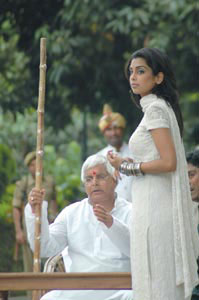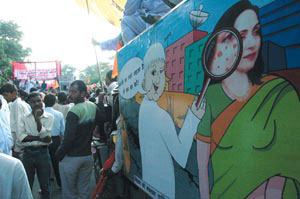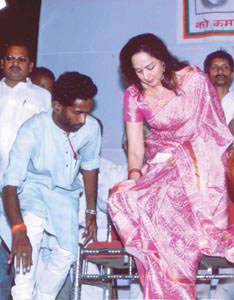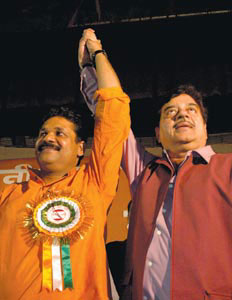Magazine
Filmy Rajniti Chakkar

Film stars make the strangest political bedfellows.
|
Nothing is too bizarre for the India silver screen.
But Lady Sita hobnobbing with her abductor Ravana? As Indian Rajniti (politics) falls under the spell of the filmy chakkar (vortex), the stars of the silver screen are making the strangest political bedfellows. Take Deepika Chikhalia and Arvind Trivedi, Sita and demon king Ravana respectively, in the Ramanand Sagar’s television serial Ramayana, who teamed up in support of the Bharatiya Janata Party (BJP) in recent national and state elections. They could be found together on the road in BJP marked cars, their modern-day Raths, into the early hours of the morning in remote towns and villages. Film stars took center stage, both in the Lok Sabha polls earlier this year as well as the just concluded elections in Maharashtra. Take that Arnold Schwarzenegger. Reel-life has always been intertwined with Real Politics in India. Nitish Bharadwaj, Krishna in B. R. Chopra’s blocbuster TV serial Mahabharata, came to the Steel City of Jamshedpur in Jharkhand from his hometown Mumbai to contest the Lok Sabha polls on the BJP ticket. Bollywood heartthrob Jayaprada deserted her home state of Andhra Pradesh to stand for the Lok Sabha from Rampur in Uttar Pradesh as a candidate of the Samajwadi Party.
Lord Krishna may have prevailed in everyone of his epic battles in Mahabharata, but Bharadwaj didn’t quite have the steel to make it this time from Jamshedpur, the constituency from which he had won eight years earlier in the 1996 polls. Lady luck was kinder to Jayaprada, who succeeded in her maiden effort. Until recently, Bollywood stars were inclined to enter politics through the less messy route of the Rajya Sabha, which did not involve the hurly burly of an election campaign. No longer. True, Indian film stars, both in Bollywood and regional Indian cinema, have sought to influence Indian politics since 1923, then as champions of the freedom struggle with the launching of Rani Padmini, a silent film or “walkie.” Their more direct involvement in the Indian political process began some 50 years ago with the induction of the patriarch of India’s cinema world, Prithvy Raj Kapoor, into the Rajya Sabha, the Upper House of Indian Parliament, by the first Prime Minister Jawaharlal Nehru. Subsequently many of the doyens of Indian cinema, including Shabna Azmi, Sunil Dutt, Nargis Dutt, Vaijantimala Bali, Vinod Khanna, Rajesh Khanna, Dilip Kumar and Hema Malini, served in the Rajya Sabha.
Film stars also lent their support to political campaigns. As early as 1967 the “Tri-Murti” of Hindi cinema – Raj Kapoor, Dev Anand and Dilip Kumar – campaigned for V. Krishna Menon, the former Indian defence minister, in the Mumbai Lok Sabha constituency. Their magic silver touch eluded them at the ballot box, however, and Menon lost. As icons and role models, Indian film stars are now an integral part of the Indian political process. Election meetings are electrified by the participation of “Dreamgirl” Hema Malini, Dhermendra, “Shotgun” Shatrughan Sinha, Raj Babbar, Juhi Chawla, Vinod Khanna and Juhi Chawla. Even Bollywood villains, like Prem Chopra, Shakti Kapoor, Johny Lever and Gulshan Grover, are major draws at political rallies. The appeal is not one way either. Some politicians are discovering the virtues of reverse osmosis. At least four very prominent Bengali politicians, including the mayor of Calcutta Subrata Mukherjee, are acting, directing or producing films or TV serials.
Mukherjee made his film debut beside famousº actress Moon Moon Sen in Calcutta’s film industry, known as Tollywood, as an honest business executive in Chowdhury Pharmaceuticals. Trinamool Congress leader Ajit Kumar Panja is so busy in the film world that when party workers come to meet him, he often emerges in the attire of the role he is playing. In Ramkrishna, Panja plays the lead role of Ramkrishna Paramahamsa, the guru of Vivekananda. A barrister by profession, Panja has staged several film productions and runs his own theater group in Kolkata. The well known trade union leader Nepal Dev Bhattacharya recently produced a film Chaka, starring Mithun Chakravarty and Deboshree Roy. He had earlier produced Nabarun and Raja Rammohan Roy. West Bengal’s Fire Services Minister Pratim Chattopadhyay also plunged into Tollywood, acting in several films and soap operas. Tamil Nadu’s filmy “chakkar” dates back to 1949 when Tamilian film star M. R. Radha floated the Dravida Khazagham Party. Starting 1960, film stars have dominated the state’s political scene as chief ministers, including M. G. Ramachandran, C. Janaki, C. Annadurai, K. Karunanidhi and Jayalalitha. Other film stars, like Shivaji Ganeshan, S.S. Rajendran, Vijaykant and Rajnikant, are also active in politics. In Andhra Pradesh, N. T. Rama Rao, a larger than life film hero, served as chief minister. Gautami (now settled in the USA), Jayaprada, Vijaya Shanti and Sharda also proved exceedingly successful in Andhra politics. In Assam, the political importance of film stars Bhupen Hazarika, Vishnu Prasad Rava, Biju Phukhan and Pranjal Saikia cannot be overstated. On the national scene, the marker for actor as candidate was established by Big B Amitabh Bachhan, who as a Lok Sabha candidate of the Congress Party in Allahabad, shocked and trounced the veteran politician H. N. Bahuguna. Noted Indian social worker Meenakshi Swaraj, secretary of Janahit Kala Sansthan, says people associate the film stars with their reel life personae, sentimentally expecting them to crusade for their causes and rescue them against the odds, just as in the movies. That too has a long history. V. Shantaram’s famous 1957 film Do Aankhe Barah Haath, the story of a jailor who attempted to rehabilitate his prisoners, prompted hreforms in prisons both at the national and state level. Amrit Nahata create an international flutter with his film Kissa Kursi Ka in 1977. A former parliamentarian from Rajasthan, Nahata’s film was a veiled attack on Congress, Indira Gandhi and the Emergency she had declared. The film, starring Sabhna Azmi, Raj Babbar, Utpal Dutt, Manohar Singh and Rehana Sultana, evoked the wrath of the political establishment of the day. Indira Gandhi’s son Sanjay Gandhi led his Youth Congress brigade into a public campaign of intimidation, including burning down cinema halls screening the film. he film was banned in India and all copies confiscated. An original copy of Kissa Kursi Ka reached the United States, where it was forwarded to the New York Film Academy, one of only a handful of original copies to still survive. Bollywood film personalities found themselves wrapped up in the politics of the Emergency. The axe fell on “Biharibabu” Shatrughan Sinha and all time musical legend Kishore Kumar, both of whom were perceived as unsympathetic to the Congress and Indira Gandhi. Information and Broadcasting Minister K. K. Tiwari banned any film featuring Shatrughan Sinha, a supporter of opposition leader Jayaprakash Narayan. Playback singer Kishore Kumar was similarly barred from All India Radio and Doordarshan during the Emergency. He incurred the wrath of India Gandhi’s cronies for hrefusing to curry favor with the Congress Party. Dev Anand and I. S. Johar lost favor because they floated their own National Party in 1975 to protest the excesses of the Emergency. Between 1975 to 1977, several Indian film personalities fled overseas to escape the wrath of Prime Minister Indira Gandhi and her inner cabal. Memories of the censorship during the Emergency were revived this month when the new Congress government led by Prime Minister Manmohan Singh announced the sudden withdrawal of the film Loknayak on Oct 11 from the telecast schedule of the government TV channel Doordarshan. Directed by Prakash Jha, Loknayak portrays the life of the famous Indian freedom fighter Jayaprakash Narayan. A fierce opponent of Indira Gandhi’s declaration of Emergency, Jayaprakash called for “Sampoorna Kranti” or total revolution in India in 1973-74. Jha has also stirred a hornet’s nest in Bihar with a movie titled Gangajal, portraying the flourishing kidnapping industry in his home state. He roused the ire of Rashtriya Janata Dal supremo Laloo Prasad Yadav by naming the principal villain in Gangajal Sadhu Yadav, which happens to be the name of chief minister Rabri Devi’s brother and Laloo’s sala, or brother in law.
All hell broke lose when the film was released in Bihar. Theaters were burned and Jha, also a candidate for the Lok Sabha, was pelted with stones at his political rallies. Yadav denounced him as a “dull-headed filamwallah” and a “mental case who joined politics as his films are flopping.” Another RJD leader Nagendra Rai, a former playback singer turned politician, ridiculed Jha as a “100 percent pure lunatic who thrives by portraying Bihar in a wrong ways in Bollywood.” In a further challenge to Yadav, Jha announced bold plans to float his own regional party in Bihar. Jha is yet to declare the name of the proposed party, although he has said that it would field candidates from all 243 Assembly seats in Bihar. An undeterred Prakashº has also announced plans to produce two new movies on corruption and lawlessness in Bihar: Apharan and Rajniti, which between them hreflect a form of Animal Farm. The Nobel laureate George Orwell, author of Animal Farm, was born in Motihari, close to Bettiah, the domain of dreaded dacoit Bhangar Yadav from where Jha contested – and lost – the recent Lok Sabha elections. Jha still has to find his political footing, but Bihari politicians sure lilt to Bollywood lyrics. Laloo Prasad Yadav, once publicly announced that he would transform Bihar’s roads, making them as beautiful as Hema Malini’s gaal (cheeks). During the last Lok Sabha polls, BJP campaigner Pramod Mahajan on a visit to Bihar, retorted that far from matching Hema Malini’s cheeks, the incompetent Laloo government had turned Bihar’s roads as pock marked as the gaal of Om Puri. Now Laloo Prasad Yadav is on a different track. In the new central government, he has taken control of the driver’s seat as India’s railway minister. Now what kind of rajniti chakkar is that?
|






You must be logged in to post a comment Login